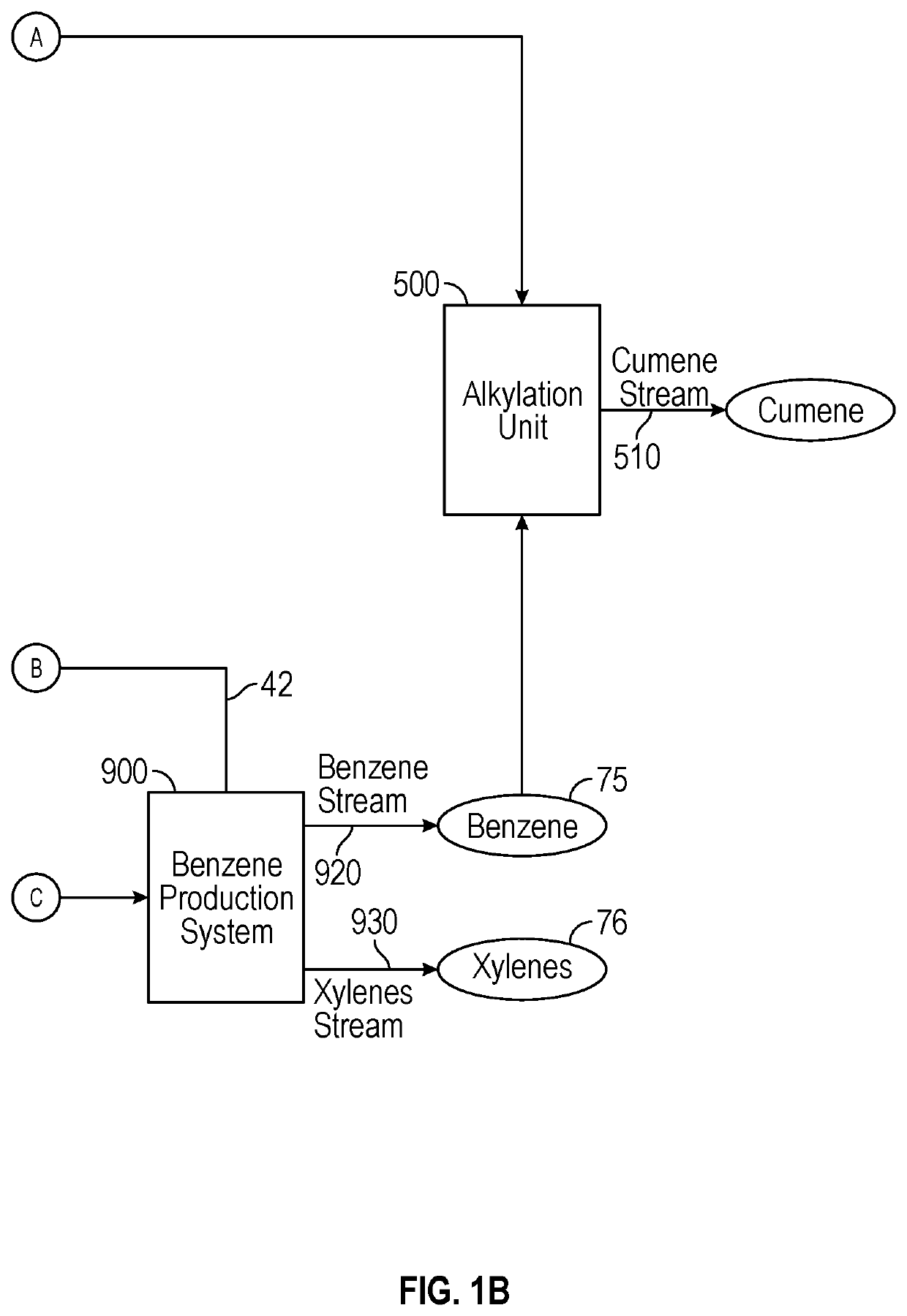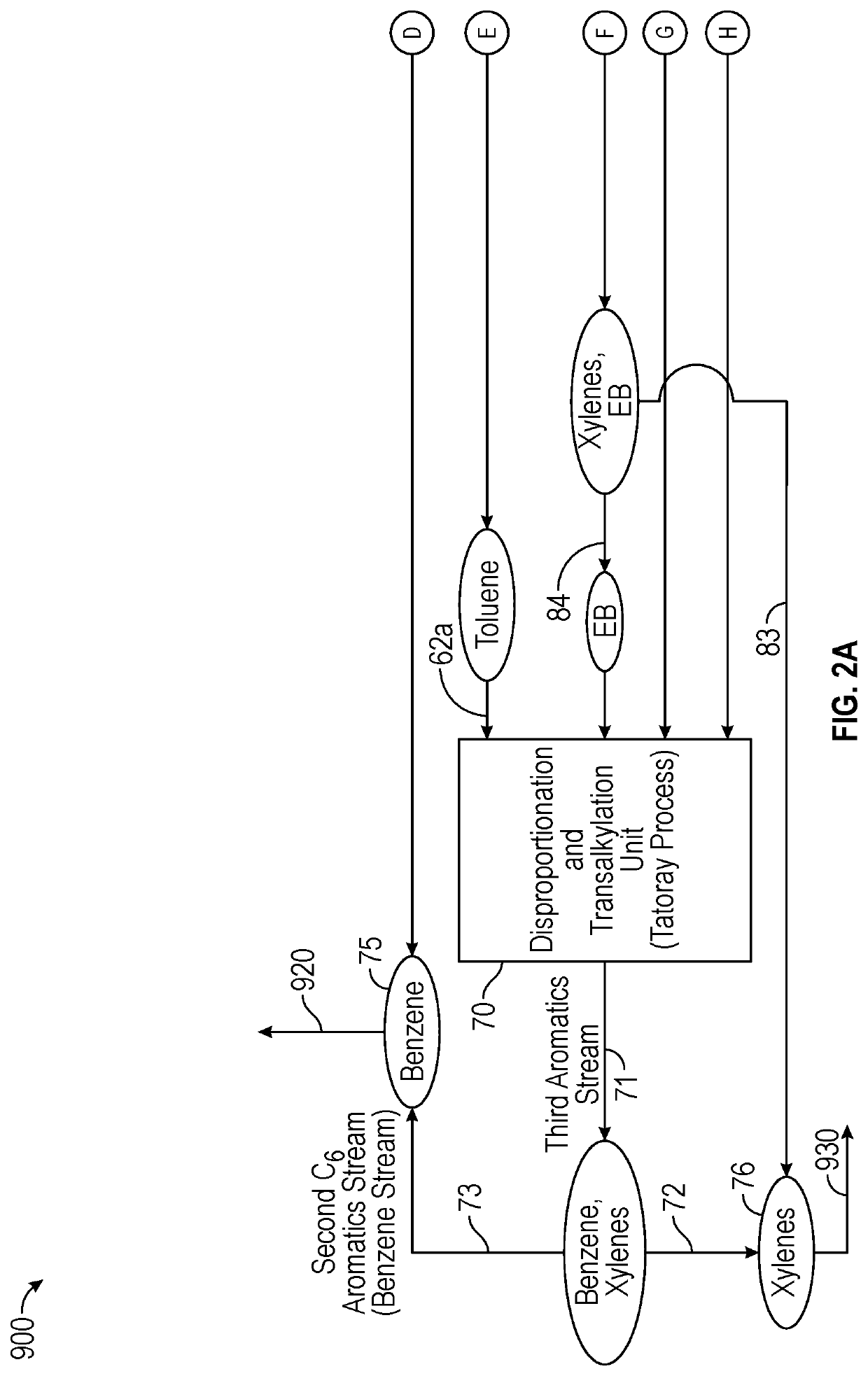Conversion of waste plastic to propylene and cumene
a technology of cumene and waste plastic, which is applied in the direction of hydrocarbon by hydrocarbon cracking, chemistry apparatus and processes, organic chemistry, etc., can solve the problems of high cost of cumene produced from petroleum feedstock intermediates and affecting the economics of the bisphenol a production process
- Summary
- Abstract
- Description
- Claims
- Application Information
AI Technical Summary
Benefits of technology
Problems solved by technology
Method used
Image
Examples
example 1
[0097]High severity pyrolysis of mixed waste plastic was conducted to investigate the production of propylene and benzene for cumene synthesis. The mixed waste plastic had 82% olefinic feed (e.g., high-density polyethylene (HDPE), low-density polyethylene (LDPE), linear low-density polyethylene (LLDPE), and polypropylene (PP)); 11% polystyrene (PS); and the remaining 7% was polyethylene terephthalate (PET). The pyrolysis was conducted in continuous catalytic cracking in circulating fluidized bed. The cracking was done with 57.5% spent fluid catalytic cracking (FCC) catalyst and with 42.5% ZSM-5 based zeolite additive and operated between 390-560° C. cup mix temperature of feed and catalyst. The feed rate of the plastic feed was 316 g / hr and the catalyst / feed weight ratio was about 30. In the case of a single stage pyrolysis process, the propylene content of the pyrolysis effluent was 23.7%, as it can be seen from the data in Table 1. The overall yield of light gas olefins was about ...
example 2
[0099]Low severity pyrolysis of mixed waste plastic was conducted to investigate the production of propylene and benzene for cumene synthesis. The mixed waste plastic had 82% olefinic feed (e.g., high-density polyethylene (HDPE), low-density polyethylene (LDPE), linear low-density polyethylene (LLDPE), and polypropylene (PP)); 11% polystyrene (PS); and the remaining 7% was polyethylene terephthalate (PET). The mixed plastic waste was pyrolyzed as described in Example 1, except for the temperature, which was about 450° C. A pyrolysis effluent was further hydrotreated to saturate all the liquid olefins, and then was further sent to steam cracking. A hydrotreated pyrolysis liquid can typically comprise 35-45% paraffins, 35-45% iso-paraffins, 15-20% naphthenes, and 5-10% aromatics, wherein the hydrotreated pyrolysis liquid boils below 400° C. The hydrotreated pyrolysis liquid could be subjected to (i) steam cracking alone; (ii) steam cracking followed by catalytic cracking with C4-C5 cr...
example 3
[0100]A mixed plastic waste was cracked in modular units at low severity conditions; or catalytically cracked in a circulating fluidized bed at high severity; or catalytically cracked in a circulating fluidized bed at low severity to produce a pyrolysis oil. The results from these cracking experiments are shown below. The cup mix temperature was varied between 400-600° C., specifically 450-550° C. Depending on the severity of the operation, the gases and the liquid products were separated. The composition of the cracked liquid product is shown below in the tables. The saturated hydrocarbons present in the gas were sent to gas crackers which were an ethane cracker or propane cracker. The gas cracker was selected depending on the desired end product. The cracked liquid from the pyrolysis unit was sent to hydrotreating to saturate all the liquid olefins, as this is a requirement for the liquid / naphtha cracker. Hydrotreating was performed at 300-450° C. and at a pressure of 20-100 barg ...
PUM
| Property | Measurement | Unit |
|---|---|---|
| temperature | aaaaa | aaaaa |
| temperature | aaaaa | aaaaa |
| temperature | aaaaa | aaaaa |
Abstract
Description
Claims
Application Information
 Login to View More
Login to View More - R&D
- Intellectual Property
- Life Sciences
- Materials
- Tech Scout
- Unparalleled Data Quality
- Higher Quality Content
- 60% Fewer Hallucinations
Browse by: Latest US Patents, China's latest patents, Technical Efficacy Thesaurus, Application Domain, Technology Topic, Popular Technical Reports.
© 2025 PatSnap. All rights reserved.Legal|Privacy policy|Modern Slavery Act Transparency Statement|Sitemap|About US| Contact US: help@patsnap.com



